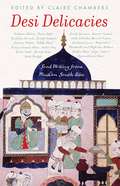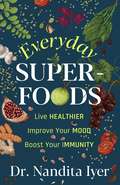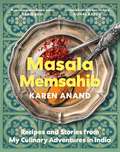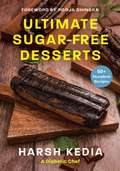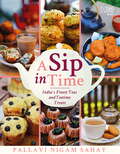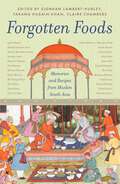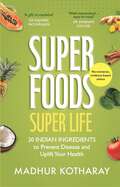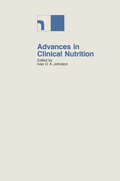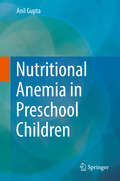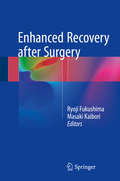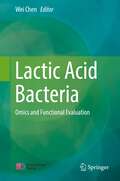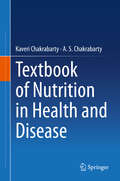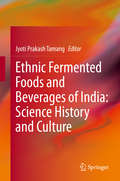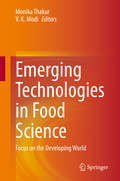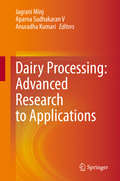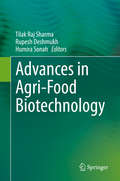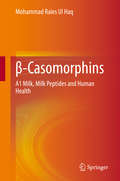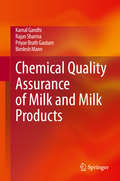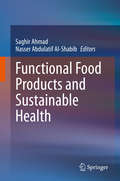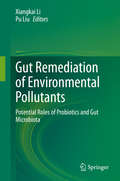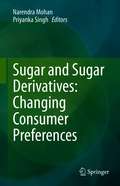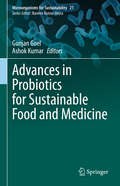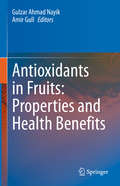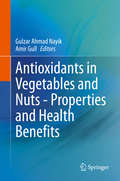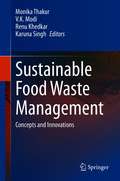- Table View
- List View
Desi Delicacies
by Claire ChambersThe kitchen is often the heart of South Asian homes. Muslim South Asian kitchens, in particular, are the engines of an entire culture. The alchemy that takes place within them affects nations and economies, politics and history, and of course human relationships. There is proof of it in Desi Delicacies, Claire Chambers’ anthology of essays, stories and recipes supplied by some of the region’s most well-loved writers, historians and chefs.An unexpected revelation awaits Nadeem Aslam in a London restaurant as he yearns for a special delicacy from Pakistan. Rana Safvi recounts the history of Awadhi cooking and the origins of qorma, while Sadaf Hussain tells us how the samosa came to be paired with chai and of his own newly found love for the beverage. Tabish Khair examines our attitudes towards food that is ‘jootha’. Death comes with an aftertaste of taar roti for the protagonist of Tarana Husain Khan’s story set in Rampur. Gulla puts his heart into making the perfect nardoo yakhni but is taken aback by a hairy surprise in Asiya Zahoor’s ‘The Hairy Curry’.A multitude of flavours blend with love, joy, grief, regret and nostalgia in this book which is not only a beautiful collection of food writing, but also a rich helping of the histories and cultures of Muslim South Asia and its diasporas.With a Foreword by Bina Shah and an Afterword by Siobhan Lambert-HurleyThe cover image is a painting from the Nimatnama, a collection of recipes partly compiled during the reign of the moustachioed Sultan Ghiyas-ud-din of the Delhi Sultanate, who features on the cover.
Everyday Superfoods
by Nandita IyerThe Essential Guide to Adding Superfoods to Your Diet, One Easy Step at a Time. In Everyday Superfoods, bestselling author and nutritionist Dr Nandita Iyer brings to you everything you need to know about easily available local superfoods and ways to incorporate them into your diet. Through 60 simple recipes using an arsenal of 39 superfoods easily found in Indian kitchens, this book will not just help you understand your relationship with food but also show you how to improve your eating habits and enrich your daily meals with the goodness of superfoods. This book includes:-Details on specific superfoods for boosting immunity, treating diabetes and for better skin and hair;-Daily meal plans, how to shop for the right superfoods, the kind of utensils to use for cooking, superfood swaps, creating your own recipes, cooking for lunch boxes and how to set up a kitchen garden;-A serious look at sustainability in superfoods, including more biodiverse produce, reducing food waste and being a conscious consumer. At a time when living healthier is paramount, this book will act as an essential guide to unlocking the very best attributes of your food.
Masala Memsahib: Recipes and Stories from My Culinary Adventures in India
by Karen Anand‘I have never seen a book on Indian food written and designed like this . . . with such beauty and recipes that work . . . Bound to be a great success!’ SALVATORE FERRAGAMO, CEO – Il Borro ‘Karen Anand possesses the meticulous manner of the French in documenting a recipe, but has free-spirited taste buds and a soul that’s quintessentially Indian. That makes this journey through the foods of India particularly delicious!’ JAMAL SHAIKH, National Editor – Brunch ‘Karen Anand takes us on an exciting journey of discovery to places and tastes and smells through her wonderful compilation of stories and recipes. Savour it’ TARUN TAHILIANI, fashion designer ‘This book on Indian cuisine by Karen Anand is a spectacular culinary event. Every lover of Indian food will drool over her “favourite home-style recipes”, collected over a lifetime of great dining experiences. I’m blown away by the beauty of her book’ KABIR BEDI, actor Karen Anand’s name is synonymous with all things food. When she writes and describes food, I can almost smell and taste it. This book is the culmination of a journey of this gourmet and I am lucky to have inhaled the aromas!’ DIVYA SETH SHAH, actor ‘The recipes in Masala Memsahib are as fragrant as the adventures from memsahib Karen’s life spent documenting Indian food. Her love for fresh organic ingredients is no secret and through this book she brings in the old-world nostalgia of uncomplicated Indian cooking’KUNAL KAPUR, celebrity chef ‘For me, Karen Anand has been a lighthouse as far as food, recipes, ingredients and the history of recipes are concerned. I’m so happy about this book from someone I truly admire and respect’MARIA GORETTI, celebrity chef and actorA celebrated food writer serves up a delicious diversity of Indian foods in this dazzling cookbook-memoir. Self-professed ‘Masala Memsahib’ Karen Anand takes us on a journey across five Indian states – Goa, Gujarat, Kerala, Maharashtra and West Bengal – and introduces us to mouth-watering local cuisines, diverse eating practices and fabulous culinary histories. Each of the book’s sections is a window into Karen’s remarkable adventures with food, interspersed with the most distinctive recipes from the regions she visits, from the piquant prawn balchao to the soulful Mulligatawny.Illustrated throughout with absorbing photographs from kitchens as well as the streets, this spectacular cookbook from one of India’s most well-loved and widely travelled food writers goes far beyond the tired tropes of Indian cooking and brings home the authentic tastes and qualities of our nation’s myriad cuisines. Packed with 100-plus ludicrously delicious, easy-to-use recipes, it is a true collectible.
Ultimate Sugar-free Desserts: 50+ Decadent Recipes
by Harsh KediaDELICIOUS SUGAR-FREE TREATS FOR DESSERT PEOPLEDiagnosed with diabetes at age fifteen, Harsh Kedia spent the next few years of his life having to forego all of his most-loved desserts. Deprived of birthday cakes, laddus and all things sweet as a teenager, he decided to create recipes that would allow everyone suffering from diabetes to have their favourite foods again.In Ultimate Sugar-free Desserts, Kedia, popularly known as ‘A Diabetic Chef’ on social media, shares more than 50 recipes to whip up delectable treats using stevia, a plant-based sugar substitute. With home cooks in mind, he covers an astonishing variety of some of our favourite desserts, from indigenous sweets such as gajar ka halwa, rasmalai and sandesh to gourmet delicacies like strawberry custard tarts, éclairs and peanut butter cookies, along with a mouth-watering array of healthy smoothies and lip-smacking beverages. It’s time to have your cake and eat it too!
A Sip in Time: India’s Finest Teas and Teatime Treats
by Pallavi Nigam SahayIn an exclusive blend for experts and enthusiasts alike, well-regarded chef and tea connoisseur Pallavi Nigam Sahay brings together culinary expertise, wide-ranging travel and her passion for the beverage in a sumptuous visual book, lush with photographs. Infused with personal experience, her exploration of the various kinds of Indian tea, their histories, and the unique qualities that make them coveted around the world, it brings alive the taste and aroma of each tea it encounters - from the traditional Phalap and the robust varieties growing in Assam to the fragrant Darjeeling and the delicately nuanced brews from Arunachal and Munnar. Lovingly paired with the teas are recipes for over 60 delectable dishes - spanning cakes, puffs, biscuits and sandwiches to breads, cookies, chaats and muffins - making A Sip in Time the perfect companion for teatime tete-a-tetes for home chefs and foodies alike.
Forgotten Foods: Memories and Recipes from Muslim South Asia
by Tarana Husain Khan, Claire Chambers, Siobhan Lambert-HurleyWhile heritage foods still abound in the streets and kitchens of South Asia, it may just be a matter of time before many of these historic dishes and culinary traditions, especially of Muslim provenance, pass into oblivion. In Forgotten Foods, historians, literary scholars, plant scientists, heritage practitioners, writers and chefs come together to document precious stories and memories, histories and recipes in a valiant endeavour to stem this lamentable tide.Introducing us to the legendary poet Faiz Ahmed Faiz’s modest, homely tastes, his daughter Moneeza Hashmi draws our attention to dishes that continue to cut across the seemingly impermeable India–Pakistan border. In Sri Lanka, Rizvina Morseth de Alwis finds comfort in the ‘strange’ recipes of her country’s Malay cuisine. A lost kitchen cabinet in Bhopal holds the secret behind the tenderest shami kababs. A journey through the rich foodscape of Manipur’s Pangal community depicts its close ties to the dietary traditions of marginalised groups. Tarana Husain Khan visits Rampur’s paddy fields on a quest for heritage rice varieties, even as we experience the sweeter side of Hyderabad’s cuisine generally notorious for its heat. A cornucopia of other essays familiarise us with uncommon items such as Kerala’s jeeraga kanhi, Kashmir’s saada saag and the delicate murgh qorma of Awadh.The culinary diversity showcased in Forgotten Foods not only comes as a delightful surprise, it also proves just how profoundly Muslim kitchens have reshaped alimentary practices, enriching South Asian food and making it what it is today.
Superfoods, Super Life: 20 Indian Ingredients to Prevent Disease and Uplift Your Health
by Madhur KotharaySuperfoods have been integral to India’s culinary traditions for centuries. But using them effectively can often seem complex. Madhur Kotharay debunks this misconception, offering clear ways to leverage these nutritional powerhouses for improved well-being. From the heart-preserving properties of garlic and blood sugar-stabilizing capabilities of cinnamon to the immune-boosting effects of amla and liver-protecting benefits of turmeric, each chapter explores the advantages of 20 Indian superfoods and reinforces how simple lifestyle and dietary changes can not only prevent disease but also reverse some of its damage.The book offers:- Comprehensive coverage of 20 versatile superfoods found in Indian kitchens- In-depth insights into the health benefits of each ingredient- Directions on how to select, store and consume- Scientifically supported data on their nutrient value- Actionable guidelines on incorporating these foods into diets for a balanced, healthy lifestyle
Advances in Clinical Nutrition: Proceedings of the 2nd International Symposium held in Bermuda, 16–20th May 1982
by I. D. A. JohnstonThe advent of any new and effective therapy is soon followed by large numbers of publications in which the indications and benefits are explored critically. It is not unexpected, therefore, that within five years of the first Bermuda Symposium on advances in parenteral nutrition that a second Symposium was considered appropriate to review progress and explore new areas of investigation, as well as enlarging the scope of the meeting to include enteral nutrition. The rate of progress can be judged by the number of subjects which were not discussed at the first Symposium. For example, home parenteral nutrition, computer assisted assessment and prescribing, Studies of body protein synthesis and breakdown and the role of branched-chain amino acids are all new subjects for this Symposium which were not covered at all in the first meeting. Much progress has also been made to our understanding of the biochemi cal complications of parenteral nutrition and the problems related to long term access to the circulation. Nutritional care has become safer and more effective. There is an increasing awareness of the difficulties in making a true nutritional assessment in selecting patients for total parenteral nutrition and more attention has also been focussed on different approaches to enteral support in the management of undernourished patients. There is also continuing debate on the cost effectiveness of this expensive method of treatment and critics look in vain for evidence of efficacy based on controlled trials in specific groups of patients.
Nutritional Anemia in Preschool Children
by Anil GuptaThe book highlights intricate predisposing factors for pathogenesis of nutritional anemia. It delivers valuable information related to this public health hazard influencing the nutritional health of preschool children. The book is valuable for readers in diverse fields to gain insight of the concept of nutritional anemia in preschool children. Additionally, book furnishes clinical and laboratory methods in a comparative way to assess nutritional anemia. Impact of the disorder on health of preschool children has been covered in a simple language. The book mentions need for interventional strategies for the management of nutritional anemia. Infants, preschool children and women during pregnancy and lactation are highly susceptible to dietary deficiency of iron, folic acid and cyanocobalamin leading to comparatively, higher predisposition to development of nutritional anemia. The condition has myriad of ill effects on nutritional health of preschool children.
Enhanced Recovery after Surgery
by Ryoji Fukushima Masaki KaiboriThis book provides up-to-date information and practical approaches to Enhanced Recovery after Surgery (ERAS) programs for digestive and / or cardiopulmonary surgery. ERAS programs following surgical interventions are now part of the standard of care for patients undergoing various operative procedures. These programs have been associated with reductions in complications, in length of hospital stay after surgery and in related costs, and have led to improved patient QOL. Enhanced Recovery after Surgery discusses a range of aspects of the program, from surgical procedure to perioperative management. Each chapter is written by experts in the field, including digestive, cardiopulmonary and pediatric surgeons. It is a valuable resource for surgeons, nurses and administrators interested in initiating an ERAS program.
Lactic Acid Bacteria: Omics and Functional Evaluation
by Wei ChenThis book discusses the latest research and new techniques in the field of lactic acid bacteria, including comparative genomics, transcriptomics, proteomics and metabolomics. It also introduces the omics and functional evaluation in detail and shows the links between lactic acid bacteria and gut health and host immunity. Summarizing the biotechnological advances in lactic acid bacteria for food and health, it is a valuable resource for researchers and graduate students in the fields of food microbiology, bioengineering, food science, nutrition and health.
Textbook of Nutrition in Health and Disease
by Kaveri Chakrabarty A. S. ChakrabartyThis textbook offers a concise, yet comprehensive account of human nutrition, food and nutrition-related health problems, based on the curricula of top universities around the globe. Nutrition is a multidisciplinary science, and as such, the book discusses various aspects of physiology, biochemistry, pathology, immunology, medicine, food science, and other fields related to nutrition, it focuses on the role of nutrition in the maintenance of health. The various chapters explore highly relevant issues, such as, addiction-related health problems, lifestyle-related disorders, social health problems and poor-maintenance of food hygiene and food safety. It also addresses the role of nutritional therapies for mental disorders, and includes an integrated perspective on cognition, oxidative stress and nutritional interventions in aging. Other topics include, the role of gut microbiota on human health, nutraceuticals as therapeutic agents and ketogenic diets. It also highlights malnutrition (protein energy malnutrition, starvation, malabsorption syndrome, eating disorders and overnutrition/obesity) and adipose tissue as an active endocrine organ. Moreover, it examines key concepts concerning the role of vitamins in the citric acid cycle (gluconeogenesis, ketogenesis, oxidative deamination and transamination) and precursors of coenzymes, as well as calorigenic hormones, appetite-stimulating/appetite-inhibiting hormones, anabolic and catabolic hormones affecting protein metabolism, and lipogenetic/lipolytic hormones.
Ethnic Fermented Foods and Beverages of India: Science History and Culture
by Jyoti Prakash TamangThis book provides detailed information on the various ethnic fermented foods and beverages of India. India is home to a diverse food culture comprising fermented and non-fermented ethnic foods and alcoholic beverages. More than 350 different types of familiar, less-familiar and rare ethnic fermented foods and alcoholic beverages are traditionally prepared by the country’s diverse ethnic groups, and include alcoholic, milk, vegetable, bamboo, legume, meat, fish, and cereal based beverages. Most of the Indian ethnic fermented foods are naturally fermented, whereas the majority of the alcoholic beverages have been prepared using dry starter culture and the ‘back-sloping’ method for the past 6,000 years. A broad range of culturable and unculturable microbiomes and mycobiomes are associated with the fermentation and production of ethnic foods and alcoholic drinks in India. The book begins with detailed chapters on various aspects including food habits, dietary culture, and the history, microbiology and health benefits of fermented Indian food and beverages. Subsequent chapters describe unique and region-specific ethnic fermented foods and beverages from all 28 states and 9 union territories. In turn the classification of various ethnic fermented foods and beverages, their traditional methods of preparation, culinary practices and mode of consumption, socio-economy, ethnic values, microbiology, food safety, nutritional value, and process optimization in some foods are discussed in details with original pictures. In closing, the book addresses the medicinal properties of the fermented food products and their health benefits, together with corresponding safety regulations.
Emerging Technologies in Food Science: Focus on the Developing World
by Monika Thakur V. K. ModiThis book provides a comprehensive review of recent innovations in food science that are being used to tackle the challenges of food safety, nutritional security and sustainability. With a major focus on developing nations, like India, the book is divided into four main sections. The first section provides an overview of the food industry, while the second explores food safety in various segments, with an interesting account of street food safety – an important, yet often neglected aspect for safety parameters. The third section, on nutritional security and sustainability, explores various ways of maximizing nutrition and optimizing waste management in the food industry. The book closes with a section on emerging technologies and innovations, which introduces readers to some of the latest technologies in the food industry, including advances in food processing, packaging, nanotechnology, etc. The topics have been divided into 25 different chapters, which offer a diverse blend of perspectives on innovations in the developing world. Ideally suited for students and researchers in the food sciences, the book is also an interesting read for industry experts in Food Science and Technology.
Dairy Processing: Advanced Research to Applications
by Jagrani Minj Aparna Sudhakaran V Anuradha KumariThis book focuses on advanced research and technologies in dairy processing, one of the most important branches of the food industry. It addresses various topics, ranging from the basics of dairy technology to the opportunities and challenges in the industry. Following an introduction to dairy processing, the book takes readers through various aspects of dairy engineering, such as dairy-based peptides, novel milk products and bio-fortification. It also describes the essential role of microorganisms in the industry and ways to detect them, as well as the use of prebiotics, and food safety. Lastly, the book examines the challenges faced, especially in terms of maintaining quality across the supply chain. Covering all significant areas of dairy science and processing, this interesting and informative book is a valuable resource for post-graduate students, research scholars and industry experts.
Advances in Agri-Food Biotechnology
by Rupesh Deshmukh Tilak Raj Sharma Humira SonahThis book presents biotechnological advances and approaches to improving the nutritional value of agri-foods. The respective chapters explore how biotechnology is being used to enhance food production, nutritional quality, food safety and food packaging, and to address postharvest issues. Written and prepared by eminent scientists working in the field of food biotechnology, the book offers authentic, reliable and detailed information on technological advances, fundamental principles, and the applications of recent innovations. Accordingly, it offers a valuable guide for researchers, as well as undergraduate and graduate students in the fields of biotechnology, agriculture and food technology.
β-Casomorphins: A1 Milk, Milk Peptides and Human Health
by Mohammad Raies Ul HaqThis book compiles the latest research on the A1 and A2 forms of cow milk, and attempts to show a correlation between the type of cow milk consumption and reported incidence of certain diseases (type 1 diabetes mellitus, cardiovascular diseases, sudden infant death syndrome and neurological disorders). Cow milk generally contains two types of β-casein, A1 or A2. The book describes the A1/A2 hypothesis, its foundation and the genetics behind it. It discusses the two forms of milk and why one is considered more harmful than the other. Seeking to provide a balanced view of the milk types, the book’s initial chapters highlight the structure, function and physiological activity of β-casomorphins. Subsequent sections describe the health concerns associated with A1 milk, and the various case studies and research surrounding it. In turn, the arguments against the hypothesis put forward by EFSA, American Nutritionists and Truswell are also highlighted. The book does not make any recommendations for dairy consumers; rather, it is a collection of essential data both in favour and against the hypothesis. Further mechanistic studies involving well-designed animal and human trials at the cellular, molecular, biochemical and immunological levels will be needed in order to draw sound conclusions. Overall, the hypothesis is fascinating, and possibly significant. However, verified and authenticated research with reproducible results is needed to make final consumer recommendations. This timely book offers a valuable resource for researchers and students of dairy science, as well as industry experts.
Chemical Quality Assurance of Milk and Milk Products
by Kamal Gandhi Rajan Sharma Priyae Brath Gautam Bimlesh MannThis book discusses quality-related aspects of milk and milk products, covering the various analytical procedures for testing the quality and composition. It also describes the adulteration of milk and milk products and the common as well as advanced techniques used to detect such adulteration. Further, the book examines food laws, guidelines and regulations laid down by FSSAI, CODEX, ISO, IDF and USFDA, and addresses the functioning of a number of international and national organizations, including the WTO, Codex Alimentarius Commission, and BIS. Familiarizing readers with the concepts of QC, TQM, PDCA cycle and related concepts of quality assurance, the book also provides information on other topics that indirectly contribute to the quality of milk and milk products, like the calibration of milk testing equipment, quality of water used in milk processing and the standardization of various chemicals used for testing. This book is a valuable resource for researchers and industry professionals dealing with dairy products.
Functional Food Products and Sustainable Health
by Saghir Ahmad Nasser Abdulatif Al-ShabibThere is a growing global awareness of the link between good diet and health. This fascinating book reviews various functional foods or nutraceuticals and the bio-active compounds they contain in order to identify the role of bioactive compounds such as nisin, micronutrients, and hydrocolloids in the diet in overall human health. It also provides up-to-date information on functional elements like antioxidants, dietary fibres, pre & probiotics, vitamins and mineral-enriched foods in the human diet. Consisting of fifteen chapters, the book offers a systematic review of the key factors in the preparation of functional foods from selected sources, and also describes the processing, preservation and packaging of a range of functional food products. This book is a valuable resource for students and researchers working in the field of food science, food technology, and nutrition, as well as for industry experts.
Gut Remediation of Environmental Pollutants: Potential Roles of Probiotics and Gut Microbiota
by Xiangkai Li Pu LiuThis book focuses on probiotics and gut microbiota, as well as their roles in alleviating the toxicity of various environmental pollutants, presenting the latest research findings and explaining advanced research methods and tools. At the same time, it offers suggestions for future research directions. Further, the book introduces readers to the concept of gut remediation, a potential approach to reducing environmental-pollutant toxicity in vivo, based on modulation of gut microbiota using probiotic supplements. Lastly it provides suggestions for further reading.
Sugar and Sugar Derivatives: Changing Consumer Preferences
by Narendra Mohan Priyanka SinghSugarcane enjoys a prominent position among agro-industrial crops and is commercially grown in 115 tropical and subtropical countries around the world. However, fluctuations in sugar prices have forced the sugarcane industry worldwide to broaden its revenue base by moving from single-commodity manufacturing to a range of value-added products. Utilizing the by-products in an innovative manner to create value-added products is the new course of action for sugar-producing countries. For many years sugarcane was regarded as a single-product crop, i.e., only useful for producing sugar. Its actual potential is now increasingly being recognised by the industry and there is a growing trend toward the manufacturing of allied products from sugarcane. Therefore, the focus is now on the establishment of sugar-agro-industry complexes, processing not just sugar but a range of other products. This book provides a comprehensive overview of sugarcane not only as a source of sweetening agents but also for many other uses, including as a source of bio-energy. It also explores the trend of sugar consumption and suggests practices to curb the consumption of sugar products in order to tackle obesity and reduce public health costs. The book underscores the need to diversify sugarcane and highlights means of doing so, while also addressing various innovations and technologies being developed in connection with sugar, sugar derivatives, and sugar industry by-products for sustainable utilization in the sugar-agro industry. Accordingly, it offers a valuable resource for professionals and R&D units in the sugar industry, and for students of agronomy and related fields.
Advances in Probiotics for Sustainable Food and Medicine (Microorganisms for Sustainability #21)
by Gunjan Goel Ashok KumarThis book focuses on probiotics as sustainable foods and medicines, discussing issues such as screening and identification of probiotics, health claims, and advances in processing technologies, as well as food safety. Based on sound scientific research, the book is a unique reference resource for food scientists interested in development of probiotic based functional foods and their marketing. It will also appeal to those working in the area of regulations regarding the use of and health claims for fermented foods, both locally and globally.
Antioxidants in Fruits: Properties and Health Benefits
by Gulzar Ahmad Nayik Amir GullThis book provides a comprehensive review of the antioxidant value of widely consumed fruits. Each chapter covers the botanical description, nutritional & health properties of these popular fruits. Fruits are one of the most important indicators of dietary quality and offer protective effects against several chronic diseases such as cardiovascular diseases, obesity, and various types of cancer. In order to effectively promote fruit consumption, it is necessary to know and understand the components of fruits. In addition to underscoring the importance of fruit consumption’s effects on human diet, the book addresses the characterization of the chemical compounds that are responsible for the antioxidant proprieties of various fruits.Given its scope, the book will be of interest to graduate and post-graduate students, research scholars, academics, pomologists and agricultural scientists alike. Those working in various fruit processing industries and other horticultural departments will also find the comprehensive information relevant to their work.
Antioxidants in Vegetables and Nuts - Properties and Health Benefits
by Gulzar Ahmad Nayik Amir GullThis book covers the nutritional and nutraceutical profiles of a wide range of popularly consumed vegetables and nuts. The first half of the book focuses on popular vegetables, and describes how higher vegetable consumption reduces the risk of diseases ranging from diabetes to osteoporosis, diseases of the gastrointestinal tract, cardiovascular diseases, autoimmune diseases and cancer. The book also includes an interesting section on the antioxidant potential of mushrooms. In turn, the second half discusses the nutritional value of various nuts. Nuts are nutrient-dense foods with complex matrices rich in unsaturated fats, high-quality protein, fiber, minerals, tocopherols, phytosterols and phenolics. The respective chapters illustrate how the consumption of nuts could ward off chronic diseases like hypertension, cancer, inflammation, oxidative stress, high blood pressure, coronary heart disease etc. In order to effectively promote vegetable and nut consumption, it is necessary to know and understand the nutritional and nutraceutical profiles of vegetables & nuts. Given its scope, the book will be of interest to students, researchers, food scientists, olericulturists, dietitians and agricultural scientists alike. Those working in the vegetable and nut processing industries, horticultural departments and other agricultural departments will also find the comprehensive information relevant to their work.
Sustainable Food Waste Management: Concepts and Innovations
by Monika Thakur V. K. Modi Renu Khedkar Karuna SinghThis book discusses one of the biggest challenges of the food industry, which is waste management. Food industries generate high amounts of waste, both solid and liquid, resulting from the production, processing and consumption of food. Stringent environmental legislators have made the task of waste management more challenging. Through the three sections of this book, the readers are introduced to the different types of wastes generated, utilization of waste through food processing industry and sustainable waste management technologies. The different chapters describe how the biomass and the valuable nutrients from food industry wastes could be used to develop value-added products. The book reiterates that food wastes and their by-products are an excellent source of sugars, minerals, dietary fiber, organic acids, bio active compounds such as polyphenols, carotenoids and phytochemicals etc.This book is an excellent resource for industry experts, researchers and students in the field of food science, food processing and food waste management.
